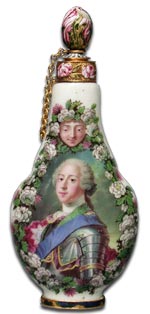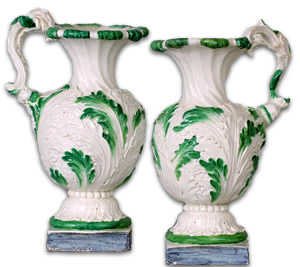Contents
The History of the Naples Porcelain company and how Capodimonte porcelain fits in.

To trace the history of Naples Porcelain you have to look at the origin of Capodimonte Porcelain, the wares and the crowned N mark and periods.
And; how production of Capodimonte Porcelain Figurines and floral displays dates back to the early eighteenth century and to the Kingdom of Naples.
The father of Capodimonte porcelain is considered to be Charles of Bourbon (1716-1788)
Son of Philip V of Spain and his second wife, the Italian Elizabeth Farnese.
Charles was coronated King of Naples and Sicily on August 3rd. 1734 in Palermo Cathedral becoming Charles VII (1738-1759).
In 1738 he married Maria Amalia daughter of the King of Saxony, Augustus III of Poland and grand-daughter of Augustus II, Elector of Saxony and King of Poland and founder of the first European hard paste porcelain factory in Meissen in 1710.
It was from this union that Charles' interest in porcelain production in Naples first sprang.
His desire was to create a porcelain manufactory of a quality comparable with the electors factory in Saxony, and whose methods and ingredients were only known by the chemist Bottger
Charles initially allocated a small building in the Royal Palace to be dedicated to porcelain production under the direction of Giovanni Caselli and the chemist Livio Ottavio Schepers, who had originally worked at the Neapolitan Mint.
In spite of many efforts, including underhand methods, the formula remained a mystery and after many investigations Charles finally concluded that the conditions in his little building were not suitable for porcelain production, there being insufficient space for the ovens and driers.
In 1743, Charles commissioned the construction of a new factory in the Royal Wood of Capodimonte, by the architect Ferdinando Sanfelice.
The History of Capo di Monte Porcelain
After vast research conducted throughout Italy to find a suitable substance to manufacture porcelain of a quality equal to the Chinese porcelain, deposits of kaolin were finally discovered at Fuscaldo and Paola in the Province of Catanzaro.
Charles VII immediately ordered brushes and painting equipment from Dresda; gold used for gilding was obtained from crushed Ungheris and Zecchinis. Charles employed the chemist and son of Livio Schepers, Gaetano Schepers, who perfected the porcelain paste .

The miniaturists Giovanni Sigismondo Fischer from Dresda and Ferdinand Sorrentino from Naples painted snuff-boxes.
Knobs on walking sticks were mounted in gold by the Frenchman Pietro Chevalier and the Neapolitan Antonio de Laurentis.
The products manufactured at Capodimonte in this period included plates, vases, small and large bowls, tea and coffee cups, large and small jugs, sugar bowls, tea caddies, teapots, snuff-boxes, and walking stick handles mounted in gold.
In 1759 Philip V of Spain died and Charles took up the Spanish throne becoming Charles III King of Spain (1759-1788).
Prior to his departure from Naples he ordered the demolition of the Royal Factory and transported all moulds, models and artists with him to Spain to found the porcelain factory Buen Retiro near Madrid, in an attempt to preserve his secret of porcelain manufacture and to leave almost no trace of the origin of his discoveries.
Charles' son Ferdinand (1751-1825) succeeded his father to the Neapolitan throne becoming Ferdinand IV King of Naples (1759-1816) and later as Ferdinand I King of the Two Sicilies (1816-1825).
Ferdinand inherited his father's passion for porcelain and, as a relatively young man of twenty, he charged the Brigadier Marquis Ricci with the task of creating a new factory at the Royal Villa at Portici, appointing him as director. At the same time Ferdinand also ordered that all the remaining porcelain, tools and machinery from his father's original factory be brought to the Royal Palace at Naples where the methods of Charles' original porcelain production were discovered. Construction of the new factory commenced in September 1771 and finished in February 1772 and production began.

The modellers at this time were Francesco Celebrano and Francesco Chiari. The painters included Carlo Coccorese who had worked in Charles' factory prior to its destruction and who had returned from Spain to find work and recognition under Perez. Perez also increased the staff, employing in particular Saverio Grue, son of the painter Francesco Antonio Grue. Saverio was well known for his painting abilities and for his porcelain sculpture.
In this period the shape, style and decoration of the porcelain production was similar to that of the original Capodimonte factory. The factory output was relatively small employing few artists and
was destined either for the Court or for visiting royalty or nobility.
In 1779 Domenico Venuti replaced Perez as director of the Royal Factory.
Under Venuti's orders the remains of Charles' original porcelain factory, which had been found abandoned at the Royal Palace of Portici and which included plaster copies of Grecian busts found in the Herculaneum excavations, where brought to the Royal Palace of Naples and used as models for the sculptors and painters.
Venuti proposed the creation of a special academy, The Academy of the Nude (l'Accademia del Nudo), which Ferdinand founded in December 1781.
The aim of this academy was to return to the study of the antique and pure principles of art which had been abandoned in favour of a more fashionable genre. One of the first artists to give lessons in this academy was Costanzo Angelini, whose studies and nude works occupy pride of place in Italian art alongside those of the sculptor Antonio Canova.
Under Venuti's direction production at the Royal Factory reached its zenith and its artistic splendour became famous throughout Europe.
Of particular note are the production of two porcelain cases for two table clocks that play minuets. These clocks represented two different themes; on one the four empires of the world are represented, and on the other the change from night to day is represented. The sculpting and painting of these pieces was executed under the direction of Venuti and Giacomo Milani respectively. The clocks were so beautiful that two songs were written after their two creators.
In 1782 Ferdinand ordered the production of a special dinner service intended as a gift for his father, Charles III of Spain, and the founder of the original Capodimonte factory.
This service was decorated with images of the vases and pictures found in the Herculaneum excavations and a special ninety four page catalogue was also produced by Venuti and Vincenzo Flauti.
These gifts accompanied by two of the artists involved in their production, Giacomo Milani and Antonio Cioffi, were sent to the Spanish Court. Their reception, however, was fairly cold and the hospitality and appreciation of the Spanish King's court was found wanting. The artists were not even permitted to present their work to the King and they returned to Naples deeply offended and very disappointed.
In 1785, Ferdinand ordered the production of another special "Etruscan" dinner service for George III, King of England.
Ferdinand also ordered the production of a publication in which Venuti was to describe the decoration of the service in French. Gaetano Carcani the director of the Royal Press was ordered to print one hundred copies of the book on Imperial Paper and a further six copies on Dutch Paper. The service was finished in April 1785 and the printing in May of the same year.
The book consisted of 157 prints, the first of which was a sepulchre uncovered at Nola. Each of the others represented individual pieces of the service modelled in shape and subject on the designs of different painted vases found in the excavations at Nola, Herculaneum, Pompei and in other parts of the Kingdom of Naples. At the end of the volume there was a large illustration depicting Tasconte, King of Etruria, presiding over the gladiatorial games.
The famous modeller Filippo Tagliolini accompanied this service to London and presented it to George III . In a subsequent letter to Venuti, Tagliolini reported that the King was overwhelmed with gratitude on receiving such a beautiful gift.
The service was thought to be lost, but was later found in one of the cupboards in Windsor castle where it had been placed for safekeeping during restoration work.
Other porcelain dinner services were also produced for the Duchess of Parma; General Acton; a certain Mr. Batson and others. Famous clients of the Royal Factory included the English Admiral, Horatio Nelson, who wished to acquire the beautifully modelled figurines in Bisquit of the King, Queen and all the Royal Family.
It is reported that Nelson, after having asked their price, was informed that not only these pieces, but any others he desired were to be given as a gift to Nelson from Ferdinand IV King of Naples. In a letter to Lord Saint Vincent Nelson described the event concluding "C'est très-beau de la parte du roi".
In early 1799 both the French invasion and the Neapolitan revolution took place.
Ferdinand had fled to Sicily with the Royal Family in December 1798; leaving the throne of Naples and the Royal Factory to the mercies of the invading armies.
Domenico Venuti tried to protect the Factory from looting by the Neapolitan people and from the control of the French invaders led by the French General, Jean-Etienne Championnet.
Venuti was unsuccessful and much destruction took place including the removal of valuable porcelain by the French forces by day and the stripping of lead from the Factory roof by night.
According to Venuti in a subsequent communication to the King, the most intense damage was suffered in the first 47 days of the Revolution whereafter, the Jacobite General, MacDonald, reinstalled order and assigned Venuti the responsibility of reforming the Factory workforce.
Venuti, however, wished to return home to his native Livorno and handed in his notice to the French forces. The French did not accept his resignation and maintained that his presence at the Factory was necessary.
For the first three months of the their occupation the French paid nothing towards the upkeep of the Factory or the salaries of the workers, some of whom were reduced to begging for money.
In February 1799 the Roman Commissioner, Guibert, was appointed by Championnet to oversee the running of the Factory,
He started to pay amounts not exceeding 2000 ducats per month to the employees and craftsmen to cover both their salaries as well as to purchase the necessary materials for porcelain production.
The Neapolitan Revolution capitulated on the 19th June 1799 and on the 10th of July Ferdinand returned to Naples from Palermo.
Guibert continued to maintain the financial role in the factory during and after Ferdinand's return. During this time the actual expenses incurred associated with the running of the factory exceeded the projected sums paid by Guibert and in the period from February 1799 to September 1801 the factory had overspent by about 12,000 ducats. At this point Ferdinand was obliged to intervene and formed a committee to manage
the affairs of the royal factory.
This committeee consisted of a temporary manager Ugolino Ganucci, Planelli, Domenico Venuti, the mineralogist Savarese and Gaetano d'Auria who were given the immediate task of examining all aspects associated with improving the running of the factory.
Of particular interest at this time was the production of a porcelain dèjeuner originally commissioned by Queen Maria Carolina (the sister of Marie Antoinette) in 1799. This dèjeuner was intended as a gift for Admiral Nelson and consisted of 12 plates on which his famous sea battles were depicted together with his portrait and initials.
In addition Nelson was to be given a glove-box made from Vesuvian lava stone decorated in gold and 12 small silver spoons with handles made from Eastern agate presented in an ornamental mahogany case.
The preparation of materials for these items had originally been made by the artist Michele Arnaud prior to the Neapolitan revolution and the same artist was charged with its completion almost a year later.
In July 1801 Gannucci was succeeded in his position of temporary manager by Felice Nicholas and from this period onwards the number of employees and artisans in the factory was greatly reduced. In 1802 the number of managerial roles in the Factory as well as the workforce was reduced even further. At this time the Director of Painting was Gaetano Milani and the Modelling Director was Filippo Tagliolini. The rest of the workforce consisted of 12 employees in the sales warehouse, 2 mould modellers, 7 painters, 2 modellers and one turner. The Royal Factory continued to produce beautiful porcelain but albeit on a much smaller scale.
In 1805 Ferdinand decided to show his gratitude to the factory workers and decreed that they should receive six percent of the annual sales as well as their usual salaries. This money was distributed to the workers at the end of each year and in various proportions depending on their various roles. Even those who were employed on a daily basis were included providing they had not stopped working for one complete year.
In 1806 the French occupation of Naples led by the invading army of Napoleon's elder brother, Giuseppe Bonaparte, continued; and Ferdinand was again forced to return to Palermo and Giuseppe Bonaparte was named King of Naples.
In March 1807 the French military occupation wanted to forego responsibilty for the Royal Factory and in May of the same year it was transferred to Giovanni Poulard-Prad, a representative of an anonymous company made up of Giovanni Plan, Gabriele Gaspard Junoz and Luigi Ippolito Beranger. A deposit was paid by a certain Carlo Rilliet a merchant and native of Geneva.
A franchise was granted to Poulard & C. for porcelain production under the provision that the porcelain quality and manufacturing process was improved, or at least that the production was maintained at a comparable quality to the original production and also that the transportation of the moulds and plans was forbidden. In addition all the drawings, moulds and other tools were handed over to this company for 3000 ducats and the gardens, presbytery and adjacent buildings of the Church of Santa Maria della Vita were rented out for porcelain production for a further annual sum of 50 ducats. Poulard then, at considerable expense, converted these buildings into an establishment suitable for the manufacture of quality porcelain.
In 1808 Gioacchino Murat, the commander of the French occupational forces in Spain, was nominated King of Naples in place of Giuseppe Bonaparte. Murat was popular with the Neapolitan people at that time as he had taken back Capri from the English and had restored law and order and promoted many public works. He had also abolished the last surviving structures of feudalism in Naples.
Murat's reign came to an end shortly after the Congress of Vienna in 1815 where the return of the "legitimate" sovereign, Ferdinand IV, was sanctioned. At this point Murat demanded the return of the whole of Italy to the French (The Proclamation of Rimini 30th March 1815). On the 2nd of May 1815 Murat's troops were decimated by the Austrian forces at Tolentino and Murat fled to France and then to Corsica. Murat was shot an dkilled during a campaign on the 13th October 1815 in Pizzo.
Ferdinand returned to the throne of Naples in 1816 as Ferdinand I King of the Two Sicilies (1816-1825).
On his return, a proposal for the confiscation from Poulard, of the newly constructed factory, was proposed. But in February 1816 Poulard drew up a contract with the Borbonic government whereby all rights of ownership were confirmed and all buildings of the Church of Santa Maria della Vita used for porcelain production were given to Poulard as his sole property. A further clause stated that on his acceptance of the above, Poulard had to pay one third of all monies he received to all the artists workers and employees of the original Royal Factory.
However, the porcelain industry was in decline and in May 1818 Poulard sold half of the factory buildings, moulds, lathes, tools and models as well as unused pastes and unfinished works to Claudio Guillard and Giovani Tourné for 6200 ducats.
In August 1819 Poulard sold the remaining half of the factory to Francesco Paolo del Re for 3000 ducats and the rest to del Re in December of the same year for a final 3700 ducats. This effectively concluded the life of the Royal Factory which had served to inspire european porcelain production for 64 years.
The naples crowned 'N' mark was copied by many other porcelain manufacturers.
The Crown and Neapolitan N, was originally painted or impressed on porcelain and ceramics produced at the Royal Factory in Naples from 1759 to 1780 and was a mark added to the finest quality Naples porcelain and ceramics from that period.
However, the present day Capodimonte porcelain logo is not a guarantee of porcelain or ceramic quality on its own. Neither is it a guarantee that the product is in fact even porcelain or ceramic.
The Crowned 'N' in blue is found on most Capodimonte porcelain figures, normally in addition to a backstamp or factory mark or a name.
But the Capodimonte Crown and N was never fully protected and as the name Capo-di-Monte can now be used to indicate a "Style of Capo-di-Monte"; it's important that collectors ensure they only collect models from the best factories and that they look for the backstamps or signatures that indicate a figure's pedigree.
The masterpieces of the Royal Factory of Capodimonte are astonishing in their demonstration of Italian skill and craftsmanship.
In little more than half a century the Royal Factory at Capodimonte produced the finest porcelain and ceramic dinner ware and ornaments in its own superb unique and complete style. In particular the Bisquit which does not redden with age (unlike those of Saxony and Sèvres) and the miniatures, which are beautifully modelled and of superb detail; and which are said to be the rarest and most prized of all European or Capodimonte Porcelain.




Leave a Reply
You must be logged in to post a comment.